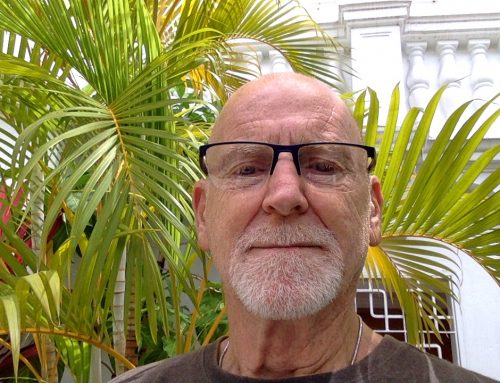The first week of my grad school program in dance/movement therapy and counseling I found myself at an inpatient psychiatric hospital, holding a set of keys that would get me onto all of the locked units. I was considered a student extern, meaning that I did not work for the hospital, but was there as a student to shadow my supervisor, an established and accomplished dance/movement therapist.
The first 20 weeks of the program you spend at your first practicum site and you attend twice a week, initially shadowing and then eventually leading certain parts of the session. In the beginning, you literally follow your supervisor around and participate in sessions and get to know the clients.
The program randomly assigns you to a placement and when I found out I was going to be in a hospital I was scared and unsure of what to expect. During new employee orientation, they scare you with all the worst case scenarios, which include all the different ways you can get attacked. By the time I got to my first day, I was terrified of everyone and afraid that I would do things to trigger people in the hospital. While I am very familiar with some diagnoses, I had never met someone with schizophrenia or any other type of psychotic disorder and had no idea what to expect.
Looking back I’m frustrated with the organization for not talking about the clients more like real people who are going through a really hard time. My school didn’t do a good job of preparing those of us who were placed in hospitals with what to expect. To top it all off, I have my own mental health diagnosis that made it really hard to not identify with the clients, particularly in the beginning when I was literally just a group participant and observer.
I distinctly remember being handed my keys and my supervisor going over the protocol with me; never put them down unless you stick them in your bag and put it under your chair, wear pants with pockets so you can keep them safe. The biggest thing I remember was when she told me to try not to jingle them when I walked because many of the clients have spent time in prison and jangling keys can be a trigger because guards tend to jangle keys to demonstrate power. That’s when I became hyper aware of all of my movements, afraid I might “set someone off.”
I remember walking down the hall with my supervisor on one of the units and she said hello to someone and asked how they were doing. I remember thinking “why would you ask someone in here that, of course they’re doing horribly!” My hackles were up and I was afraid to get too close to anyone, especially the bigger men.
The main emotion I felt at the end of the day was not fear, but anger. Anger at the injustice of the system. Anger that there are people out there who need to be in the hospital. And anger that I was fear-conditioned to work in this environment. Yes, you need to be careful and not leave anything with a cord laying around or lose your keys on the unit, but first and foremost you need to treat the people on the other side of those doors as people.
The fact of the matter is, we’re all just one bad incident away from being on the other side of those doors. This is why it’s important to treat everyone the way you would want your brother or your mother or yourself to be treated. As someone who has a diagnosis, I always had a sense that it wouldn’t take much to put me on the other side of the door, this time without keys.
The hardest part of working in the hospital was the countertransference, which is the emotional response that the therapist has in response to the client. I had it on both sides; I saw myself in many patients and I also saw family members. Working with the older adults at one of my hospital jobs was hard because I worked with men my dad’s age who, like my dad, were Vietnam vets. I worked with suicidal older adults who were isolated, many who were widows or widowers. I worked with younger clients who had experienced trauma and were battling with self-harm and the diagnosis that I have.
In the end my skin wasn’t thick enough. I couldn’t ward off the way that working with these people made me feel. The system is so unfair and many times people were kept in the hospital either way too long against their will or for too short a time for us to make a difference. The saddest would be when a client would return a few days later after an overdose or a(nother) suicide attempt or breakdown.
One of the hospitals where I worked had an administrator who didn’t understand why a behavioral health hospital needed therapists. There was a lack of support and it’s really hard to keep going when you’re not valued by the head of the hospital or members of the treatment team.
I went through an incident that forced me to leave my job at the hospital 2 years ago. I have bipolar disorder and for years I had kept it under control with therapy and medication, but the year leading up to this incident I had been neglecting self-care and ignoring the way the hospital was affecting me emotionally and psychologically. My mood had become unstable and I was unpredictable, irritable, and unhappy.
One day when I was getting ready for work I was so overcome with dread at the thought of stepping foot in the hospital that I threw myself down a flight of stairs. It was a few days before Christmas and I had already planned on being away later that week so I told my boss that something happened and I was unwell and unable to make it in. The weeks that followed were hard and scary, with several more incidents happening and engagements in other types of self-harm.
I’m pretty sure that I didn’t end up in the hospital through the sheer will of my family, my husband, and my therapist and psychiatrist. We upped my meds. I was never left alone. I stopped working. I went to therapy. And yet it continued.
After 6 months I thought I was better and went back to work at the hospital where I had done my first student externship as a full-time dance/movement therapist. The first week there I started having what we later learned were stress-induced migraines, which for me look like dizziness, light-headedness, and falling down. I took 2 trips to the ER within a week of each other because we didn’t know what was wrong and it kept happening at work. I lasted maybe a month.
I decided that maybe my problem was that I couldn’t handle all the responsibilities of working as a full-time employee in the hospital, but that maybe if I was part-time I would have a better time of it. I started working at a different hospital on weekends and on a per diem basis and after just a few short months the migraines were back and I was unable to handle it.
The first self-harm incident and realization that my mood was unstable happened 2 years ago. After I stopped working in the hospital things got better for a little while but then a year ago it flared up again. Now, a year later, I feel in control and stronger than I have in several years. But I’m still aware that, just like always, I’m one bad incident away from being on the other side of those doors.
I decided to share this part of my story, which is important to note that it’s only one part, because I think it’s important to talk about mental health. I want to take the shame out of having a diagnosis or needing help.
I’ve only been on one side of those hospital doors, privileged enough to hold keys, but like I’ve said multiple times in this post I am acutely aware that I am just one incident away from being on the other side. We all are. Treat yourself with kindness and compassion and know that it’s ok to need help. And many of the people giving the help have been where you are.

Allie Linn is a freelance writer, a therapist, and a dancer who lives in Philadelphia, PA. She writes about mental health to spread awareness and destigmatize mental illness. Allie hopes to use her writer’s voice to help people battling mental illness feel understood and heard and also to take away the stigma. Allie was diagnosed with bipolar disorder when she was 19 and PTSD when she was 26. She is currently 32 and fights everyday to find balance and peace.








Leave A Comment